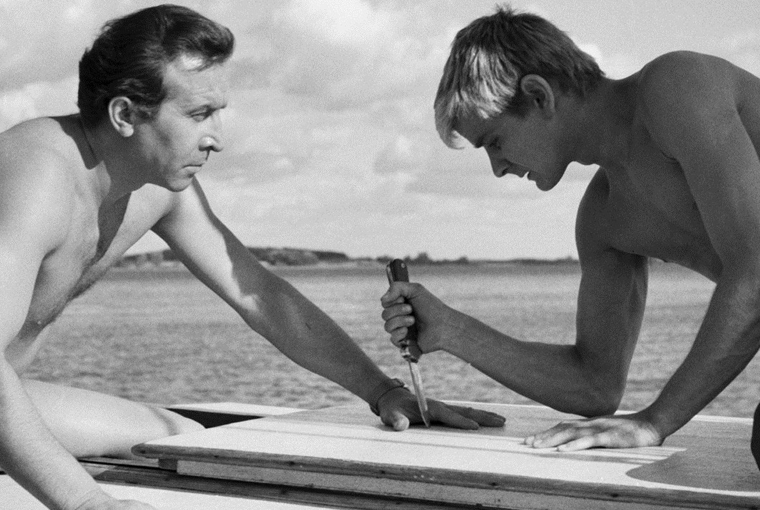For the Virtue of a Knife
Roman Polanski’s Knife in the Water (Nóż w wodzie, 1962)
Vol. 5 (May 2011) by Moritz Pfeifer
“…you could use a dirk to trim vine branches and a knife and many other instruments.”
“Certainly.”
“But nothing so well, I take it, as a pruning-knife fashioned for this purpose.”
“That is true.”
“Must we not then assume this to be the work or function of that?”
“We must.”
– Plato, Republic
All sorts of symbolic meanings can be attributed to the knife that is at the center of the Knife in the Water, Polanski’s first feature film about a fierce power-play between three people who go out sailing on a lake. According to most critiques, the knife underlines the aggressive tendencies between the two male characters who are in an awkward conflict about the older man’s wife, Krystyna. This conflict foregrounds perhaps the film’s most well-known scene: the knife game between the anonymous hitchhiker and his “opponent”, Andrzej, where they alternately stab a knife quickly between the out-stretched fingers of the other’s hand. For many, the knife is a purely phallic symbol. It represents the virility for each man who holds it causing penis envy or castration anxiety, or both. Others have provided an essentialist interpretation of the knife, referring to its cinematographic meaning. Simply put, a film has to be “cut.” The fight between the two men is therefore also a fight between two opposing generations of filmmakers, a “tool” used to incise into formalist discrepancies.
These interpretations are subject to varying levels of validity, and it is not my objective to refute them. However, one question remains. Is it not rather strange that the knife in Polanski’s film does not have additional meaning, other than its symbolic distortion? A knife is a utensil, its obvious function is to cut. But the knife fulfills this function only once in the entire film, when Andrzej cuts off the boat’s halyard rope after it hit a sandbank. Even the the young man, who is the owner of the knife, admits that the knife “has no function” on the water, as he exposes it for the first time to help cut radish for lunch. And it turns out that Krystyna prefers her butter knife.
Before a knife can be read as a phallus, an editing style, or a symbol of power, it is an instrument designed for a specific purpose, that a knife alone achieves, and achieves better than any other tool. A knife’s specific achievement, is the simple observation that it can cut. The famous passage in Plato’s Republic quoted above denotes exactly that. It is also a passage often used to exemplify Aristotle’s thoughts on ethics. A knife can cut well or badly, and it has certain characteristics or virtues by which its cutting function can be judged. If all of these functions are fulfilled, the knife is a good knife; if they are missing, then it is a bad knife. We can tell that a knife is a good knife by testing the knife’s virtues and by observing what it can achieve with these virtues. The good of a knife is what it can achieve through its being sharp, well crafted, safe, etc.
Now the virtues of the knife in Polanski’s film are not put to test. This does not mean that the knife doesn’t lack the “goodness” Aristotle writes of – but perhaps that the good virtues are just silenced by the symbolic fuzz that surrounds it. If cutting is its virtue however, the knife is indeed in a strange position: perhaps even one of alienation. Indeed, the knife’s traits are deformed by strange attributes that not even a “bad knife”, a knife that lacks the virtues to cut, could possibly identify with.
It is funny that the trained eye searching for meaning is not disturbed by the knife’s lack of function. On the contrary, for the person looking for meaning, this search becomes the knife’s function. Unlike the knife, this person will not be bothered or estranged by the attributes that replace the knife’s virtue. Nothing is more exciting than symbolic discovery.
Of course, in a way the spectator is forced to place the knife in this role, because this is what is happening in the film. The knife would need a human being to prove its virtues, but there is no one in the film to do this, so it is because of the characters that the knife is unable to reveal its characteristic traits. But in making the knife purely symbolic as the characters in the film do, the spectator might be closer to the character’s interpretation (and their relationship with the knife) than is appropriate. So why restate the obvious, when the problem is not so much to decipher what specific meanings are attributed to the knife, but that no matter what those meanings are, they have nothing to do with the knife.
The real tragedy in this film is therefore not that of the characters’ but that of the knife and it is not surprising that Polanski recurrently compares crafted objects with lost beings in his films, whose virtue in a world among humans has ceased to exist. In that way, The Knife in the Water is strikingly similar to one of Polanski’s earlier short films, Two Men and a Wardrobe, where two men are coming out of the sea with a wardrobe, and return to the waters with the wardrobe, as all three are not accepted on land. Similar to the knife, the wardrobe in this film is unable to reveal its function, to prove its virtues as a wardrobe and thus ascertain its goodness. It becomes alienated, violated by laws of symbolic violence. Like the knife, it has no choice but to drown because no matter what, it did not have the chance to fully exist.
People tend to separate the things they create from themselves. Even if the knife simulates a symbolic meaning that we could likely attribute to the characteristics of a human being, we would never claim that it is a living being, that it has a mind of its own. For humans to have created a knife, is a separation that involves a change of being. All those characteristics and virtues that reside on the side of life (sharp, dangerous, powerful, piercing, etc.) now fall over to the side of the object and can no longer count as unique virtues of the human. They have to be shared with a lifeless object.
Tools thus objectify the human state of being, humanizing, in a way, the object. More and more human characteristics get lost when they are objectified, when they transform into material reality. The struggle between man and object thus becomes the landmark of a will for power, to conquer the mortal sphere of existence through eternal but lifeless inventions. Again, it is important to note that the struggle in Knife in the Water is not so much between the three characters but between the three characters and the knife. The tool is destructive because it disintegrates the characteristics of man. The characters are thus in the same alienated position as the tool. They identify with the knife for the things they lack (danger, power, sharpness, etc.). Having lost the sense of their own human virtues, they fail to consider that they could share their virtues with the knife, instead creating a futile and competitive conflict.
The knife questions our relation to it. The meaning of the knife questions our relation to ourselves. Only if the knife is seen as an object that is rooted in life, we are able to reconsider our relation to it. Only if we see that even our relation to things is inherently reciprocal, we can reconsider our relation to ourselves. We must care for the things we create. The use of an object does not have to mirror human’s triumph over life, over other people’s lives. If we see the virtue of an object, we are likely not to use it as a tool for character traits we would like to banish. A knife is a tool, and its virtue is to cut. The demand for things not to appear hostile is a question of virtue.




Leave a Comment